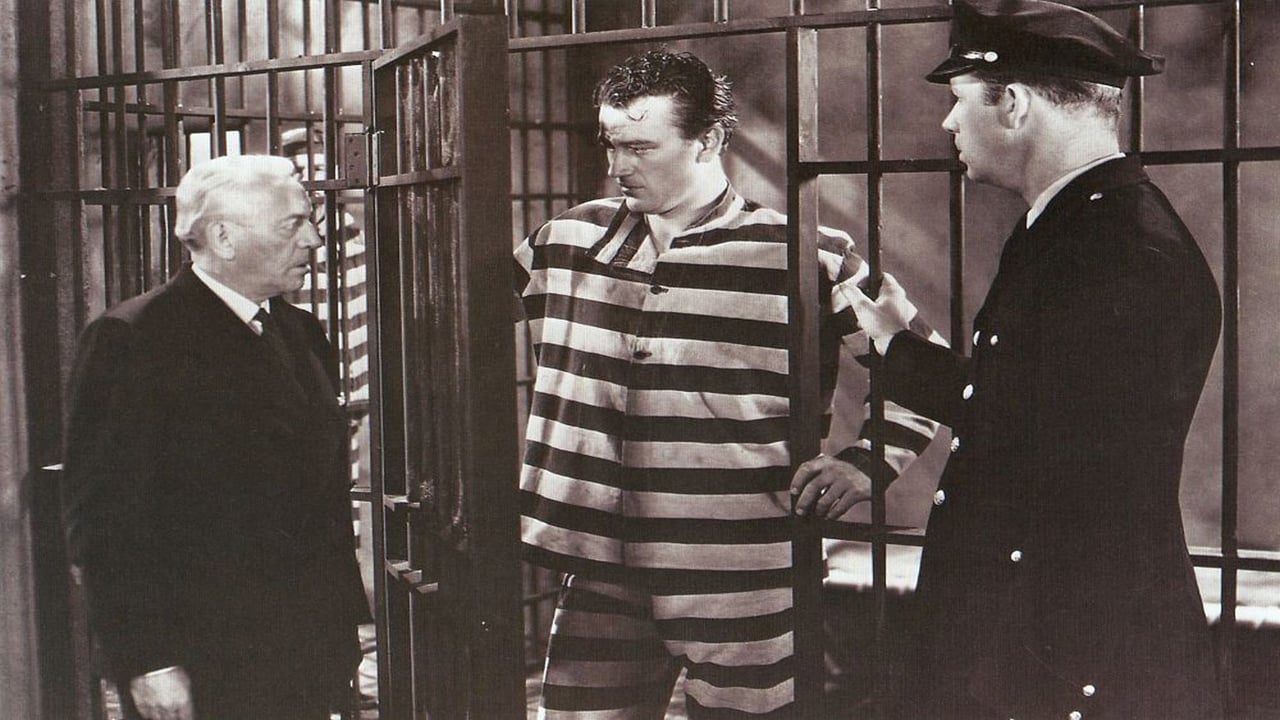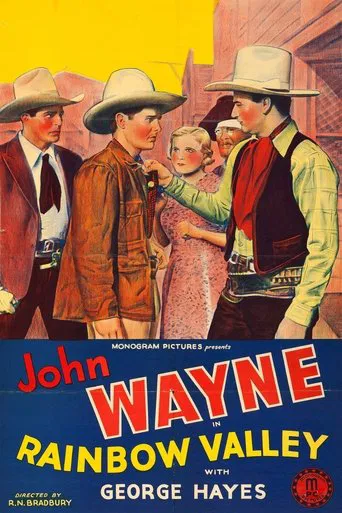GurlyIamBeach
Instant Favorite.
Derry Herrera
Not sure how, but this is easily one of the best movies all summer. Multiple levels of funny, never takes itself seriously, super colorful, and creative.
Patience Watson
One of those movie experiences that is so good it makes you realize you've been grading everything else on a curve.
Kien Navarro
Exactly the movie you think it is, but not the movie you want it to be.
weezeralfalfa
The plot of this1935 Lone Star John Wayne oater makes no sense to me! Supposedly, the road from ? to Rainbow Valley was washed out by a flash flood, and the local criminal element wants it to remain that way, to aid in their criminal activities, and induce the gold miners to abandon their diggings for the criminals to take over. But, in the beginning ,Wayne rides over the 'trail' from ? to Rainbow Valley, and meets Gabby Hayes, stuck with his primitive car needing radiator water. Wayne empties his canteen and the two resume their journeys to Rainbow Springs, along a wide 'road'. Wayne foils an attack on the auto, and Gabby continues on toward Rainbow Valley, delivering the mail to the P.O. Obviously, the existing road is good enough for an auto to traverse, so what's the problem??!!........Also, things get confusing for me near the end. Supposedly, there is a road work gang ,the criminal gang, and a citizen mob converging on the road work site. But, it looks like the mob confronts the work gang, which looks like it is the criminal gang! The whole bandit gang is blown up as they scramble to get out the way, right to where the dynamite is buried. The head criminal has a fight with Wayne, and somehow accidently pushes the plunger for this dynamite. Wayne then uses the remainder of a dynamite, which he had fenagled from the gang, to finish building the road. See it at YouTube.
Bill Slocum
Business as usual at Lone Star Studios 1935: A solid John Wayne anchors a leaden production about foiling bad guys out west.Wayne is John Martin, who shows up one day at an isolated town named Rainbow offering to help with their road problem. Since the existing road was washed away by a cloudburst, the town has been at the mercy of a gang of desperadoes, one of whom, Rogers (LeRoy Mason), plays the part of an upstanding citizen. Martin organizes the town to build a new road. As time passes, people wonder whether Martin's on the level.This is a pretty novel idea for a western, road engineering as a plot point. But the slipshod manner of the story's development creates more potholes than the finest engineer could work around.The story opens with Martin in a store, buying guns and a horse. The sequence establishes that there's a town named Rainbow that lost its road, but serves no other purpose, especially as this exposition is basically repeated shortly after when Martin meets a mail courier named George (George Hayes), who pretty much says the same thing. If you know the work of director Robert N. Bradbury on these Lone Star westerns, you won't be surprised by the padding.There's also a protracted, silly subplot about a bad guy named Butch who's been sent away to prison but is magically freed when Rogers somehow gets the townspeople's signatures on a petition for clemency. Why we need Butch in this production is never explained, nor is the reason for Martin having a suspicious prior relationship with the felon. Since it doesn't figure in the story, it's just more padding.But "Rainbow Valley" does stick out in a better way. In addition to the road idea, Wayne is in very good form here, natural and enjoyably reactive in his work with the other actors. Just as good in his own more colorful way is Hayes, not yet known as "Gabby" here but in that zone. He and Wayne play well off each other here, establishing a baseline of charm that assuages the weakness of the storyline.There's a fun bit where Martin is trying to talk up a pretty mail clerk who, suckered in by Rogers, has no time for him. As she cuts Martin off and walks away, George looks on, impressed: "She's fallen for you already."If you like Wayne and Gabby Hayes, you will like this movie at least a bit. But even they aren't enough to make me think it's good.The supporting performances are better than usual, with Mason making a mark despite a one-note role. There's clever use of an automobile (Lone Star westerns usually seem to be set in the beginning of the 20th century, though it's never stated clearly) which George carries mail in, a springy jalopy called "Nugget Nell." Dynamite explosion stunts add some excitement. And no horses seem to have been killed in the making of this film, which is good to see.But the negatives pop up too frequently. It's true these were short films, made as casual entertainments to run under an hour as part of a larger movie-house program, but "Rainbow Valley" is too casual that way, suffering from a typical lack of continuity and characters turning on a dime.At least Wayne is good, as said, and in a way that helps you see why he became such an overnight sensation just four years later. He's got the charm, the toughness, and the presence that keeps you watching even when the rest of "Rainbow Valley" lets you down. He's just playing an engineer here, but he builds a decent bridge to the future all the same.
mark.waltz
I can't write a lot on films like this. There were hundreds of low budget westerns with similar stories so they all seem almost the same. However, I liked several moments in this one, particularly a chase sequence between Wayne, Gabby Hayes and the bad men. It is Gabby who ends up the hero here, throwing dynamite down at the villains while driving a car which doesn't blow em' up, just slows em' down, scares em', and ultimately, drives em' off. It is presented humorously, making the predictable story and obvious conclusion easier to watch. It would take a couple more dozen of these before Wayne would rise to "A" list stardom with "Stagecoach", but these films passed many an hour for film fans on matinée days in a more innocent time.
John W Chance
Now we're on the weak end of the 'Lone Star' westerns. Unless you've never seen any of them, this is a retread of several tropes from earlier films in the series. If this is your first, the surprises at the end (which is well edited) will be new. Sorry to have to spoil your fun.We get that dynamite is needed to clear the trail; dynamite is used to get water flowing in the superior first film 'Riders of Destiny' (1933). We get that John Wayne has really been sent by the government to work undercover and infiltrate the gang of outlaws; as also seen in 'Riders of Destiny,' and countless other early thirties westerns such as 'The Man From Hell's Edges' (1932) with Bob Steele, etc.We get Lucille Brown as the "Prairie Flower," and Leroy Mason as the head villain, also from the better 'Texas Terror' (1935) in which Lucille gets more screen time than the villain, and when finding out that John Wayne is indeed a good guy at the end, rushes to his cabin to spend two hours alone with him! Unfortunately, she's wasted here with little to do. We get the Tin Lizzie driven by George Hayes, also featured in 'Texas Terror.' Note: In this film he sings a song! Now, if you don't think he's acting trying to walk and talk like an old geezer, watch him as the nasty, dastardly villain in the awful serial 'The Lost City'( 1935) ! We get shots of Yakima Canutt jumping on a horse, and plunging off a cliff into a river, among many shots repeated from earlier films in the series.So what does it all mean? A weak Lone Star. When you have two extensive shootouts between the road workers and the villain's gang of henchmen behind rocks in a canyon, nobody, not even the camera, is moving. Surprise, that means that the film isn't moving either! It's better to spend your time on the 'Lone Stars' with either better character development or better action such as 'Sagebrush Trail' (1933),'The Star Packer' (1934), 'The Trail Beyond' (1934), 'The Dawn Rider' (1935) or 'Texas Terror' (1935). Despite the well paced ending, this one gets a 3.


